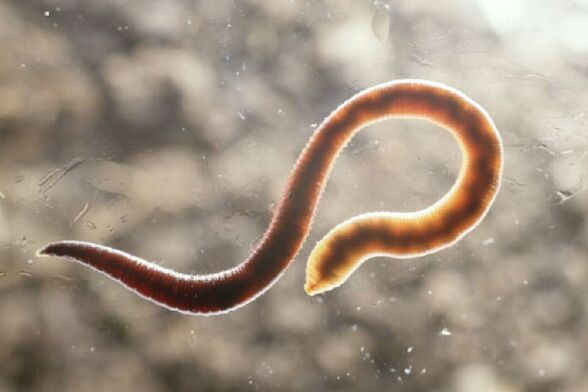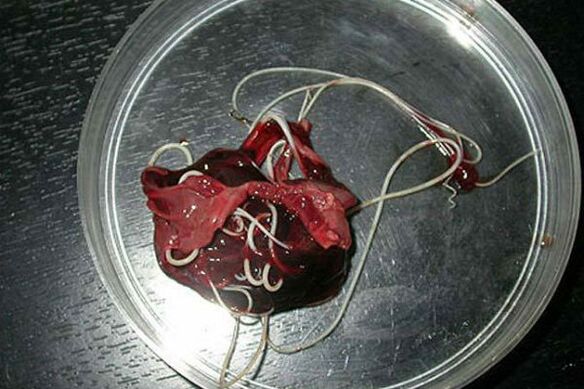
Worms in humans, the symptoms and treatment of which will be suggested by a doctor, in the human body are provoked by two types of worms: round (roundworms) and flat (flukes and tapeworms). Each of the parasites causes significant damage to the body, especially if appropriate treatment was not provided on time.
Make sure you wash your hands when you get home and also rinse any fruit or vegetables under a stream of warm or hot water, as it is on them that parasite eggs are likely to be found. Products such as fish or beef meat must necessarily undergo heat treatment. Under the action of high temperature, the meat gets rid of the eggs of various helminths and can be suitable for consumption.
Varieties of nematodes
Pinworms are small, gray-white parasitic flatworms that awaken enterobiasis.
Such parasites enter the human body in the following ways:
- food (through the oral cavity);
- through unwashed / dirty hands.
Pinworm eggs are found in unwashed fruit or vegetables or in the coat of a sick animal. Babies who scratch itchy areas of skin and subsequently ingest eggs (for example, along with contaminated food) are more likely to be infected with enterobiasis. It takes two weeks to develop pinworm larvae in the digestive tract environment, and after full development, a full-fledged worm lives in all parts of the large intestine.
Trichinella: These parasites have round bodies no longer than 5 mm and excite trichinosis in the body. Larvae and eggs prefer to be lightly fried in meat (wild boar, pork, bear). In the human body, Trichinella takes up to 4 days to become an adult and its life cycle is 40 days. The main purpose of this type of worm is to enter the bloodstream through the intestinal walls and settle in the muscles. In addition, the muscles of the respiratory and musculoskeletal systems are often affected.
Nematodes are large, spindle-shaped representatives with a red-yellow tint. Males of this species reach a size of 15-25 cm, and females - up to 40 cm. Their body is devoid of any adaptation for attachment in the intestine, they simply move to the food mass through the intestine.
You can become infected with roundworms by ingesting ripe eggs when you eat unwashed fruit or vegetables, on which the smallest particles of soil remain. After the eggs have entered the internal environment of the body, the adult larvae hatch from them, terrorizing the intestinal walls. Through the bloodstream, parasites can travel to the heart muscle and subsequently to the lungs.

Only on this the cycle of travel through the body does not end, because the larva moves through the respiratory tract into the mouth.
By swallowing the parasite again, the body already creates a favorable environment for its development.
The path of a full-fledged worm lies through the small intestine. Their life cycle is 12 months, after which they die and are excreted in the faeces.
Vlasoglavy - worms in humans, the symptoms and treatment of which are determined at any time after infection, preferring to live directly in the intestine. This worm feeds on the blood component or feeds on the intestinal mucosa.
Females lay eggs directly on the walls of the affected organ, then come out together with the feces and develop under environmental conditions. An already mature larva, the body of which is oblong, and does not exceed the limits of 5-15 mm. enters the food human body.
These parasites have round bodies no longer than 5 millimeters and excite trichinosis in the body. Larvae with eggs are found in lightly fried meat (wild boar, pork, bear).
In the human body it takes a maximum of 4 days for Trichinella to become an adult and its life cycle does not exceed 40 days. The main purpose of this type of worm is to enter the bloodstream through the intestinal walls and settle in the muscles. In addition, the muscles of the respiratory and musculoskeletal systems are often affected.
Necator / hookworm. The connection between these parasites is direct, in connection with the caused ailments and biological signs. They live in the duodenum and due to their small size (10-15 mm) they move freely in its environment.
Larvae can only enter the body through the skin if a person has been in contact with contaminated soil. An additional target of the worms are the lungs along with the digestive tract. They feed only on the blood that comes out of the bitten blood vessels. Due to the violent activity of these parasites, blood clotting is disturbed. Adults consume blood in the range 0. 1-0. 35ml per day.
Variety of flatworms

Wide ribbon. The length of the body of the parasite, which is 10-20 meters, deserves attention.
The parasite originates in freshwater fish and crayfish, the larvae enter the eggs and fish fillets.
The formation of an adult worm takes a maximum of 25 days, then a person becomes ill with diphyllobothriasis (the digestive tract is disturbed, vitamin B deficiency).
Liver fluke is a flat worm, reaching a size of 10-20 mm, and there is a second name for this parasite - cat fluke. In 50% of cases of infection suffer residents who have consumed infected fish (carp, crucian carp, bream, cockroaches). Fish are infected with liver flukes through a consumed snail that has previously consumed helminth eggs with fresh water.
To clean the fish from the parasite, heat treatment is required, otherwise the larva will enter the internal environment of the body, damaging the gallbladder with the intestines. Signs of the acute phase of the development of helminthiasis in humans are a feeling of nausea, which turns into vomiting, pain in the upper abdomen, allergic reactions, muscle spasm. The parasite creates irreversible changes in the body, and even after its expulsion from the patient's body, all kinds of inflammations and ailments certainly occur.
Swine / bovine tapeworm. The body length of the parasite is 5-6 meters, and its larvae hide in the meat of large animals (pork, cattle). The disease awakened by these helminths is called teniasis and teniarinhoz.
The larvae of both tapeworm species, the Finns, are whitish vesicles attached to the walls of the small intestine. To reach and form an adult, the parasite needs 3 months and the worm develops every day. The total number of segments reaches 2000, the last of which freely "furrows" the large intestine.
Then the worms leave the body along with the feces through the anus. The most common and obvious symptom of helminthiasis is a disturbed digestive tract, as well as food intake in large volumes and the patient does not visually gain weight.
Echinococcus. In this case, a person acts as an intermediate host, because the latter are wolves, cats, dogs. Animals can become infected through direct contact with contaminated objects or people. As soon as the eggs of the parasite enter the intestine, the larvae with six hooks immediately develop, which in medicine are called oncospheres.

The worm's preferred habitat is the lungs and liver, and the larva becomes an echinococcal cyst, increasing in size. All tissues close to it are subject to rapid destruction.
Doctors often do not detect echinococcosis and confuse it with a malignant or benign formation. In addition to compressing blood vessels and internal organs, echinococcal cyst ruptures are common.
If this happens, not only a toxic shock occurs in the body immediately, but a ruptured cyst causes the formation of several new ones.
The last type of parasite are alveococci, in the medical literature they are referred to as echinococci. It is this worm that awakens a terrible disease that causes damage commensurate with cancer and liver cirrhosis. The worm's oncospheres enter the intestine, then the embryos hatch from the eggs and begin to destroy the intestinal walls. After the walls are punctured, the parasite enters the bloodstream and spreads throughout the body.
Most often, as mentioned above, the alveococci terrorize the liver, where the larva gradually grows. In the process of development, the larvocyst forms in the worms, an aggressive formation that is rapidly increasing in size (a multi-chamber, gradually growing vesicle). These vesicles make their way into the liver cells, according to the same principle as cancerous metastases.
Neighboring tissues feel a violation of blood flow, and subsequent necrotic changes occur in them. Fibrous nodes with such multi-chamber bubbles form on neighboring structures and can remain in the human body for several years. That is why doctors, when they detect this parasite, resort to surgical intervention.
Note
Modern science knows about 280 species of worms. It is these microorganisms that can parasitize and develop in a variety of tissues and organs of the human body.
Each year, these worms in humans, whose symptoms and treatment are determined by the doctor, affect the organs and tissues of about 15 million people and most, to be more precise, 80% of them are children.
How can you get worms:
- The use of meat dishes with poor heat treatment or raw meat in general. Hence, the beef is the habitat of the tapeworm and the pork carries the pork tapeworm.
- Consumption of infected fish in lightly salted or raw form. River water is often contaminated with helminth larvae.
- Water can also cause worms. This is due to the fact that a person can drink raw water or wash food, dishes with contaminated water. The risk is particularly high when outdoors.
- Soil can also cause worms to appear. Because it can contain animal or human feces. But how do worms get into the human body? The answer is simple: through unwashed hands after working in the garden or outdoor recreation.

Also, you can get infected through direct contact with a person who has helminthiasis. That is, the infection occurs through dishes, linens or personal hygiene items.
If the case is completely neglected and the parasitic infection is in the acute stage of its development, doctors prescribe detoxifying and desensitizing therapy. And if the disease is very difficult, glucocorticoids are prescribed.
Speaking for a specific therapy, it takes into account the nature of the pathogen and involves special chemotherapeutic agents of an anthelmintic nature.
In addition, patients are advised to take various antihistamines. At the end of the treatment, you will need to follow a course of probiotics. All this is necessary to restore the intestinal microflora. In the process of treatment, the patient must follow a special diet, which consists of easily digestible foods with a minimum content of fat.
At the time of therapy, it is very important to stick to impeccable personal hygiene, otherwise there is a risk of reinfection.
In addition, all family members, as well as other people who have been in constant and close contact with the patient, should undergo anthelmintic treatment.
Signs of worms in humans: symptoms in children and adults
Signs of worms in humans, the symptoms of which may be the same, can be observed in an acute form, both in adults and in children:
- Unreasonable increase in appetite and abundant salivation and, at the same time, weight is quickly lost.
- Another variant of the development of symptoms can also occur - appetite disappears, after eating the person feels bad.
- Perhaps the appearance of headache and dizziness.
- Loose stools or constipation can also indicate the presence of worms.
- Pain in the abdomen.
- Sudden onset of an allergy of incomprehensible symptoms.
- Weakening of hair and nails (their fragility increases due to a lack of iron and vitamin B12).
- Due to the weakening of the immune system, various inflammations appear in the nasopharynx and genital area.
If the body is heavily infected with worms, a large amount of toxic substances that appear due to the vital activity of helminths are released into the human blood. This circumstance can greatly affect the baby's health. First of all, the nervous system suffers. Therefore, if a child shows sudden aggression, irritability, insomnia and other signs of nervous disorders, the child should be checked for the presence of helminths.

Even if there are no pronounced signs and there are no functional disorders, worms can be present in the human body and it is necessary to undergo regular tests to identify them.
Quite often it happens that after preventive vaccinations, a child develops an allergic reaction due to the presence in the body of toxic substances secreted by helminths.
In fact, determining whether or not there are worms based on superficial signs alone is a rather difficult task. After all, the symptoms shown can be a sign of another disease. This task is especially difficult for pregnant women. Since all of the above signs of worms in humans, the symptoms of which were described above, in pregnant women appear due to the process itself.
For this reason, the signs of helminth infection in pregnant women can be distinguished from such symptoms: itching in the anus and burning in the vaginal area, which increase at night, weight loss, fatigue, fever.
To diagnose helminth infection, a number of measures are performed, including the following procedures:
- Collection of a medical history to identify possible sources of infection.
- The study of stool and blood samples, rectal and perianal mucus, muscle tissue, sputum and bile in the laboratory. When carrying out these activities, signs of the presence of helminths in the body (eggs or worms themselves, as well as their parts) can be detected. It is also worth noting that an increased number of eosinophils can serve as a sign of the presence of worms in the body.
- Serological studies (ELISA, RSK, etc. ) allow to detect the presence of parasites at the stage of larvae or helminths living in muscle tissues.
- To determine the presence of parasites affecting the liver, ultrasound, CT and endoscopy are prescribed.
Worms in the human liver: symptoms by type of worm
Worms in the human liver, the symptoms of which largely depend on the type of helminth, can migrate to other organs as well.
The appearance of the primary signs of worm infection does not appear immediately. In many ways, the time of appearance of the distinctive features depends on the species composition of the parasites. So the presence of roundworms in almost two or three days is manifested by a deterioration in the general condition of a person.
The first symptoms of infection with other types of helminths in most cases begin to appear only two to three weeks after the end of the incubation period. There are such parasites (for example, filariasis) in which the incubation period exceeds six months.
The problem with determining the presence of helminths in the human body is that in the case of primary infection with a small number of worms or a single individual, there are practically no visual signs. Symptoms begin to appear only after intensive helminth reproduction or when they reach large sizes (broad tapeworm, nematode).
It is more reliably possible to determine pinworm infection. In their presence, a characteristic itch appears in the anus, which intensifies at night. Basically, the itching occurs within a couple of days, then disappears for about two weeks and starts again.
When infected with helminths such as tricuriasis, hookworms, schistosomiasis, diphyllobothriasis, beriberi and anemia develop.
The appearance of the symptoms of nematode infection largely depends on the period of development of the parasites. So, if they are at the initial stage of development, the larvae move through the blood to almost all internal organs and the following symptoms of the disease appear: subfebrile temperature, weakness, cough with purulent sputum, volatile infiltrates are visible on X-rays of i lungs, which subsequently disappear.
With a severe infection, bronchitis and pneumonia can develop. With the further development of parasites, there is a violation of the functions of the gastrointestinal tract.
Trichinosis - mainly manifests its presence with pain in muscle tissues, fever and swelling.
Such worms in the human liver, the symptoms of which are manifested by a jaundiced complexion, such as fascioliasis, opisthorchiasis, clonorchiasis, reveal their presence with an increase in the spleen and liver and other serious ailments of the body.
Almost all types of worms cause central nervous system disorders, while the sick person experiences severe headaches and fatigue, a generally calm person becomes irritable and impatient, and unreasonable attacks of aggression may appear.







































